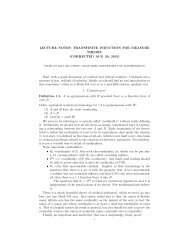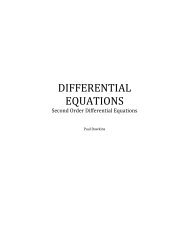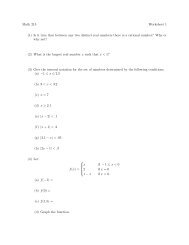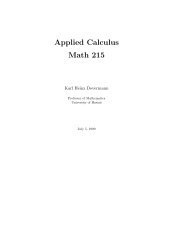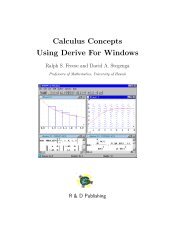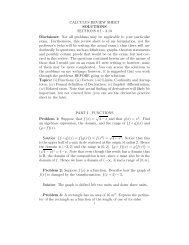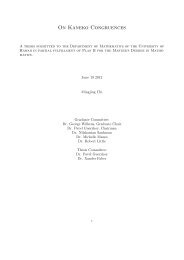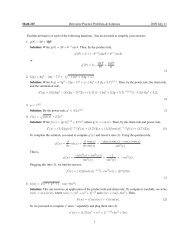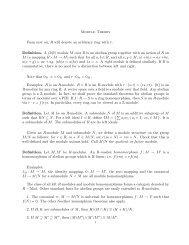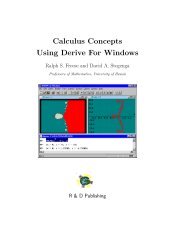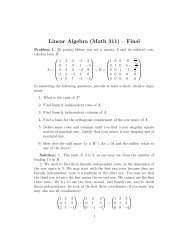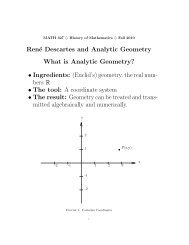Problems and Solutions in - Mathematics - University of Hawaii
Problems and Solutions in - Mathematics - University of Hawaii
Problems and Solutions in - Mathematics - University of Hawaii
You also want an ePaper? Increase the reach of your titles
YUMPU automatically turns print PDFs into web optimized ePapers that Google loves.
1.7 2007 November 16 1 REAL ANALYSIS<br />
Therefore, µ(B0) = 0, s<strong>in</strong>ce µ ≪ ν, which proves that f(x) > 0, [µ]-a.e.<br />
If B1 = {x ∈ X : f(x) ≥ 1}, then<br />
<br />
ν(B1) =<br />
B1<br />
f d(µ + ν) ≥ (µ + ν)(B1) = µ(B1) + ν(B1).<br />
S<strong>in</strong>ce ν is f<strong>in</strong>ite by assumption, we can subtract ν(B0) from both sides to obta<strong>in</strong> µ(B1) = 0. This proves f(x) < 1,<br />
[µ]-a.e. ⊓⊔<br />
6. 34 Suppose that 1 < p < ∞ <strong>and</strong> that q = p/(p − 1).<br />
(a) Let a1, a2, . . . be a sequence <strong>of</strong> real numbers for which the series anbn converges for all real sequences {bn}<br />
satisfy<strong>in</strong>g the condition |bn| q < ∞. Prove that |an| p < ∞.<br />
(b) Discuss the cases <strong>of</strong> p = 1 <strong>and</strong> p = ∞. Prove your assertions.<br />
Solution: (a) For each k ∈ N, def<strong>in</strong>e Tk : ℓq(N) → R by Tk(b) = k<br />
n=1 anbn, for b ∈ ℓq(N). Then {Tk} is a<br />
family <strong>of</strong> po<strong>in</strong>twise bounded l<strong>in</strong>ear functionals. That is, each Tk is a l<strong>in</strong>ear functional, <strong>and</strong>, for each b ∈ ℓq(N),<br />
there is an Mb ≥ 0 such that |Tk(b)| ≤ Mb holds for all k ∈ N. To see this, simply note that a convergent sequence<br />
<strong>of</strong> real numbers is bounded, <strong>and</strong>, <strong>in</strong> the present case, we have<br />
Sk <br />
k<br />
∞<br />
anbn → anbn = x ∈ R.<br />
n=1<br />
Thus, {Tk(b)} = {Sk} is a convergent sequence <strong>of</strong> reals, so, if N ∈ N is such that k ≥ N implies |Sk − x| < 1,<br />
<strong>and</strong> if M ′ b is def<strong>in</strong>ed to be max{|Sk| : 1 ≤ k ≤ N}, then, for any k ∈ N,<br />
n=1<br />
|Tk(b)| ≤ Mb max{M ′ b, x + 1}.<br />
Next note that ℓq is a Banach space, so the (Banach-Ste<strong>in</strong>hauss) pr<strong>in</strong>ciple <strong>of</strong> uniform boundedness implies that<br />
there is a s<strong>in</strong>gle M > 0 such that Tk ≤ M for all k ∈ N. In other words,<br />
(∃ M > 0) (∀b ∈ ℓq) (∀k ∈ N) |Tk(b)| ≤ Mb.<br />
Def<strong>in</strong>e let T (b) ∞<br />
n=1 anbn = limk→∞ Tk(b), which exists by assumption. S<strong>in</strong>ce |·| is cont<strong>in</strong>uous, we conclude<br />
that limk→∞ |Tk(b)| = |T (b)|. F<strong>in</strong>ally, s<strong>in</strong>ce |Tk(b)| ≤ Mb for all k ∈ N, we have |T (b)| ≤ Mb. That is T is<br />
a bounded l<strong>in</strong>ear functional on ℓq(N).<br />
Now, by the Riesz representation theorem, if 1 ≤ q < ∞, then any bounded l<strong>in</strong>ear functional T ∈ ℓ ∗ q is uniquely<br />
representable by some α = (α1, α2, . . . ) ∈ ℓp as<br />
T (b) =<br />
∞<br />
αnbn. (29)<br />
n=1<br />
On the other h<strong>and</strong>, by def<strong>in</strong>ition, T (b) = ∞<br />
n=1 anbn, for all b ∈ ℓq. S<strong>in</strong>ce the representation <strong>in</strong> (29) is unique,<br />
a = α ∈ ℓp. That is, <br />
n |an| p < ∞. ⊓⊔<br />
34 On the orig<strong>in</strong>al exam this question asked only about the special case p = q = 2.<br />
36




